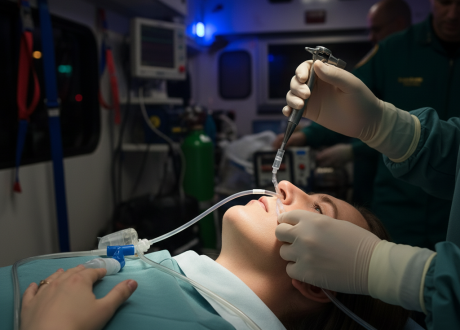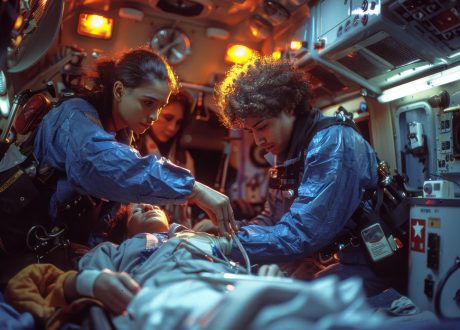Podcast: Play in new window | Download
Reference: Marx et al. Simple Aspiration versus Drainage for Complete Pneumothorax: A Randomized Noninferiority Trial. Am J Respir Crit Care Med. 2023
 Date: March 22, 2024
Date: March 22, 2024
Guest Skeptic: Dr. Richard Malthaner holds the prestigious position of Chair/Head of the Division of Thoracic Surgery and serves as the Director of the Thoracic Robotic Program at Western University’s Schulich School of Medicine and Dentistry. Dr. Malthaner currently serves as the Vice President of the Canadian Association of Thoracic Surgeons and is the founder of the Skeptik Thoracik Journal Club.
Case: A 25-year-old female medical student presents with right chest pain and dyspnea. Chest x-ray (CXR) shows a “complete pneumothorax.”
Background: The first time we got together to discuss chest tubes was on SGEM#129. That episode had two questions. The first question was in a trauma patient, how clinically useful is a CXR after putting in the chest tube?
 The answer we came up with was to put the tube on the correct side, within the triangle of safety, and within the pleural space. Continue to obtain a CXR post chest tube knowing it will probably not change management. Be more concerned if the patient is doing poorly or the tube is not draining.
The answer we came up with was to put the tube on the correct side, within the triangle of safety, and within the pleural space. Continue to obtain a CXR post chest tube knowing it will probably not change management. Be more concerned if the patient is doing poorly or the tube is not draining.
The second question we tried to answer was does chest tube location matter? The answer is that the part of the location that matters in these situations is that the chest tube is safely placed on the correct side and in the pleural space.
The next time were talking chest tubes was not in trauma patients but rather in patients with their first large spontaneous pneumothorax in SGEM#300. We only had one question asking if they all needed a chest tube. The bottom line for that episode was it’s reasonable to provide conservative management in a patient with large first-time spontaneous pneumothoraxes if you can ensure close follow-up.
We have looked at other chest-related issues with other guest skeptics. SGEM#339 looked at the optimal anatomical location for needle decompression for tension pneumothorax with Dr. Rob Edmonds. That study did not support the claim that the second intercostal space-midclavicular line is thicker than the fourth/fifth intercostal space-anterior axial line.
The most recent time we have explored something involving chest tubes was with guest skeptic Dr. Chris Root (SGEM#355). We wanted to know if the size of the chest tube matters in hemodynamically stable patients with traumatic hemothorax. That was a multicenter, non-inferior, unblinded, randomized, parallel assignment comparison trial that reported small percutaneous catheters were non-inferior to large open chest tubes for traumatic hemothorax.
Patients can present with a spontaneous pneumothorax. This is defined as air in the pleural space between the lung and the chest wall with no obvious precipitating factor. It can occur in existing lung disease (secondary spontaneous pneumothorax) or with no known underlying lung pathology (primary spontaneous pneumothorax).
Chest tube drainage remains the reference first-line treatment of primary spontaneous pneumothorax, however, complications occur in 9–26% of such cases. A less invasive alternative approach is simple aspiration, which could be an option. The best way to manage a first primary spontaneous pneumothorax episode remains unclear.
CLINICAL QUESTION: IS SIMPLE ASPIRATION NON-INFERIOR TO CHEST TUBE DRAINAGE FOR FIRST-LINE LUNG EXPANSION IN PATIENTS WITH COMPLETE PRIMARY SPONTANEOUS PNEUMOTHORAX?
Reference: Marx et al. Simple Aspiration versus Drainage for Complete Pneumothorax: A Randomized Noninferiority Trial. Am J Respir Crit Care Med. 2023
- Population: Adults aged 18–50 years with a first episode of a symptomatic completed spontaneous pneumothorax for <48 hours. Complete was defined as total separation of the lung from the chest wall.
- Exclusions: Tension pneumothorax, traumatic and recurrent pneumothorax, and primary pneumothorax associated with pleural effusion or secondary pneumothorax with underlying lung disease. Pregnant or lactating women; patients not available for follow-up; and those with major incapacitation, unable to give consent, or under trusteeship, guardianship, or judiciary protection were also excluded.
- Intervention: Simple aspiration using a polyurethane safety catheter mounted on a blunt needle (Turkel Thoracentesis Kit, Cardinal Health) placed in the second intercostal space midclavicular line. Free drainage for 15 minutes then -25 cm suction for 30 minutes. Clamp the tube and then obtain a CXR. If the lung is up the tube is removed. Monitor for 24 hours in the ED and then send the patient home. If the lung is not up, more suction for 30 minutes. If not up, chest tube drainage and the patient admitted. If the lung is up then the tube is removed.

- Comparison: Chest tube drainage (Vygon Thoracic trocar drain 16 or 20 Fr) with the tube placed in the fourth or fifth intercostal space mid-axillary line. Pleur evac drains of BPDS700 type. CXR during “evacuation…in accordance with the usual practices”. Figure 1 in the paper shows that everyone appears to have been admitted.

- Outcome:
- Primary Outcome: Pulmonary expansion 24 hours after the procedure
- Secondary Outcomes: Tolerance, adverse events, and recurrence within one year.
- Type of Study: Prospective, open-label, randomized non-inferiority trial conducted at 31 emergency departments at university and non-university hospitals in France from June 1, 2009, to March 31, 2015.
Authors’ Conclusions: First-line management of complete primary spontaneous pneumothorax with simple aspiration had a higher failure rate than chest tube drainage but was better tolerated, less invasive, and “safer.”
 Quality Checklist for Randomized Clinical Trials:
Quality Checklist for Randomized Clinical Trials:
- The study population included or focused on those in the emergency department. Yes
- The patients were adequately randomized. Yes
- The randomization process was concealed. Yes
- The patients were analyzed in the groups to which they were randomized. Yes
- The study patients were recruited consecutively (i.e. no selection bias). No
- The patients in both groups were similar with respect to prognostic factors. Yes
- All participants (patients, clinicians, and outcome assessors) were unaware of group allocation. No, no, and yes
- All groups were treated equally except for the intervention. No
- Follow-up was complete (i.e. at least 80% for both groups). Unsure
- All patient-important outcomes were considered. No
- The treatment effect was large enough and precise enough to be clinically significant. Yes
- Financial conflicts of interest. None
Results: They recruited 402 patients into the study. The mean age was 28 years, 82% were male and 60% were on the right side.
KEY RESULT: SIMPLE ASPIRATION WAS “NON-INFERIOR” TO CHEST TUBE DRAINAGE FOR FIRST-LINE LUNG EXPANSION IN PATIENTS WITH COMPLETE PRIMARY SPONTANEOUS PNEUMOTHORAX AND WAS BETTER TOLERATED WITH FEWER ADVERSE EVENTS.
- Primary Outcome: Treatment failure within 24 hours
- 29% of the aspiration group and 18% of the chest tube drainage group
- Difference 0.113 (11%) (95% CI; 0.026 to 0.200)

- Secondary Outcomes: Aspiration had less pain, less pain limiting breathing, and less kinking of the device but greater recurrence of pneumothorax.
- The aspiration group experienced less pain overall with a mean difference of -1.4 (95% CI; -1.89 to -0.91)
- Less pain limiting breathing with a frequency difference of -0.18 (95% CI; -0.27 to -0.09)
- Less kinking of the device with a frequency difference of -0.05 (95% CI; -0.09 to -0.01)
- Recurrence of pneumothorax was 20% in the aspiration group versus 27% in the drainage group with a frequency difference of -0.07 (95% CI; -0.16 to 0.02).

1. Modifying the Primary Outcome: Dynamic analysis may be legitimate but it is a red flag to be more skeptical. They explained in the manuscript:
- “The determination of an appropriate noninferiority margin is critical to the demonstration of noninferiority. Substantial discordance in the numerical inputs used for trial planning and the actual trial rates of the primary outcome during interim analyses resulted in an unplanned reevaluation of the trial analysis. Beyond the fixed approach, many authors propose computational methods that allow margin recalculation during the analysis”.
2. Statistical vs Clinical Non-Inferiority: The difference between these two concepts is something we have identified before on the SGEM but usually when discussing superiority trials. It reflects how nuanced the interpretation of the medical literature can be. The authors say the study supports a conclusion of noninferiority but then say it does not support an interpretation of clinical noninferiority. This is not a contradiction.
- “In this study, the results of simple aspiration as a first-line treatment of primary spontaneous pneumothorax argue in favour of noninferiority”
- “Despite a meaningful statistical noninferiority, the results of the primary outcome do not support an interpretation of clinical noninferiority.”
A treatment can be statistically non-inferior but still may not be considered clinically non-inferior. We can’t just look at the numbers and not consider whether the statistical threshold translates into meaningful clinical benefits. Also, there could be concerns about aspects of the treatment, such as side effects, adverse events, or long-term outcomes, that are not captured by the primary outcome of the study.
The practice of medicine should not be based on numbers alone. This important concept applies to performing a simple aspiration in a patient with a pneumothorax. While aspiration does not perform statistically worse than chest tube drainage you need to consider all factors relevant to clinical practice. This distinction is crucial in medical research and practice, as it highlights the importance of considering the broader implications of statistical findings before making clinical decisions.
 3. Determining the appropriate noninferiority margin is confusing: Non-inferiority trials are the “Devil’s Design”. There is an excellent blog by Dr. Justin Morgenstern on First10EM discussing how people don’t understand non-inferiority studies.
3. Determining the appropriate noninferiority margin is confusing: Non-inferiority trials are the “Devil’s Design”. There is an excellent blog by Dr. Justin Morgenstern on First10EM discussing how people don’t understand non-inferiority studies.
The non-inferiority margin determination is critical. The authors choose an event rate of 25% not exceeding the drainage group. This is a very large margin! Where did this come from? Were patients consulted? Would an 11% rate be considered non-inferior? NNH of 9? They then changed it using the “synthesis approach”. And then changed it using the “Moving rate of efficacy”. Then they recalculated things and truthfully, I was lost. Sorry that my math skills are not up to the hand-waving and statistical voodoo of the authors ☹
4. Type of Analysis for Non-Inferiority Trials: There is some debate around the best way to analyze a non-inferiority trial with different methods having the potential to bias the results [1]. Traditionally, a per-protocol analysis has been recommended. This analysis includes only those participants who adhered to the protocol and completed the treatment as assigned. This is considered the most conservative approach to assess non-inferiority, as it reduces the chance of bias towards non-inferiority due to protocol violations or dropouts. However, it may also introduce selection bias and reduce the generalizability of the results.
Another way to analyze a non-inferiority trial is to do an intention-to-treat analysis (ITT). This analysis includes all participants who were randomized, regardless of whether they received or completed the treatment as assigned. This is considered the most realistic approach to assess non-inferiority, as it reflects the real-world scenario and preserves the benefits of randomization. However, it may also increase the chance of bias towards non-inferiority due to crossover, contamination, or loss to follow-up [2].
You can even do a modified intention-to-treat analysis (mITT). This analysis is a compromise between the per-protocol and intention-to-treat analyses. It includes all participants who were randomized and received at least one dose of the treatment but excludes those who had major protocol violations or did not have any post-baseline assessments. This is considered a more pragmatic approach to assess non-inferiority, as it balances the trade-off between internal validity and external validity. However, it may also introduce some degree of bias or uncertainty depending on how the modifications are defined and implemented [3].
The choice of analysis for a non-inferiority trial should be based on the research question, the clinical context, and the statistical assumptions. Ideally, both per-protocol and intention-to-treat analyses should be performed and reported, and their results should be consistent and robust. If there is a discrepancy between the two analyses, it should be explained and justified.
5. What is Safer? With any intervention, there can be potential benefits and potential harms. Both potential outcomes need to be considered when evaluating the net impact of a medical intervention. The authors claim simple aspiration is safer but there was a lack of data to support this conclusion. The observed differences do not appear clinically significant. Even the recurrence rates at one year (20% vs 27%) were not statistically significant.
Comment on Authors’ Conclusion Compared to SGEM Conclusion: We generally agree with the authors.
SGEM BOTTOM LINE: NEEDLE ASPIRATION TO TREAT FIRST-TIME SPONTANEOUS PNEUMOTHORAX WAS STATISTICALLY NON-INFERIOR TO INSERTING A CHEST TUBE, BETTER TOLERATED BUT DID FAIL MORE OFTEN.
Case Resolution: You discuss the options of aspiration, tube or observation. The patient prefers to be observed in the emergency department. The patient remains stable, and a CXR two hours later shows no change in the pneumothorax. She is discharged home with good social support, clear instructions on when to return to the emergency department and a follow-up appointment with her friendly neighbourhood Thoracic surgeon the next day.

Dr. Richard Malthaner
Clinical Application: This is not what we routinely do in Canada. We don’t tend to aspirate. If you are going to insert a drain, why not leave it in and hook it up to a one-way Heimlich valve and send the patient home? Who wants to be observed in the ED with a drain overnight? We generally recommended short observation and if stable discharge home with appropriate support and follow-up. Any concern they get a small tube with a valve. I don’t see any value in this form of aspiration.
What Do I Tell the Patient? Your lung has collapsed. Traditionally we carefully insert a chest tube to re-inflate your lung. Another option, which is a chest tube, is to insert a needle in the chest to re-inflate the lung. The chest tube does work better but may have to stay in play longer and is more uncomfortable. We could also put in a small tube with a one-way valve and have you go home later today. What would you like to do?
Keener Kontest: Last week’s winner was Shawn Murphy a PA from Parry Sound. This is Shawn’s fourth win. He knew Sandra Bullock was wearing an Arizona Wildcats Jacket in the movie Speed.
Listen to the podcast to hear the question for this episode. If you think you know the answer, send an email to TheSGEM@gmail.com. The first correct answer will receive a cool skeptical prize.
REMEMBER TO BE SKEPTICAL OF ANYTHING YOU LEARN, EVEN IF YOU HEARD IT ON THE SKEPTICS’ GUIDE TO EMERGENCY MEDICINE.
- Rehal S, Morris TP, Fielding K, Carpenter JR, Phillips PP. Non-inferiority trials: are they inferior? A systematic review of reporting in major medical journals. BMJ Open. 2016 Oct 7;6(10):e012594. doi: 10.1136/bmjopen-2016-012594. PMID: 27855102; PMCID: PMC5073571.
- Students for EBM. Understanding Non-Inferiority Trials. (accessed March 21, 2024) https://s4be.cochrane.org/blog/2022/03/18/understanding-non-inferiority-trials/
- Head SJ, Kaul S, Bogers AJ, Kappetein AP. Non-inferiority study design: lessons to be learned from cardiovascular trials. Eur Heart J. 2012 Jun;33(11):1318-24. doi: 10.1093/eurheartj/ehs099. Epub 2012 May 7. PMID: 22564354.








